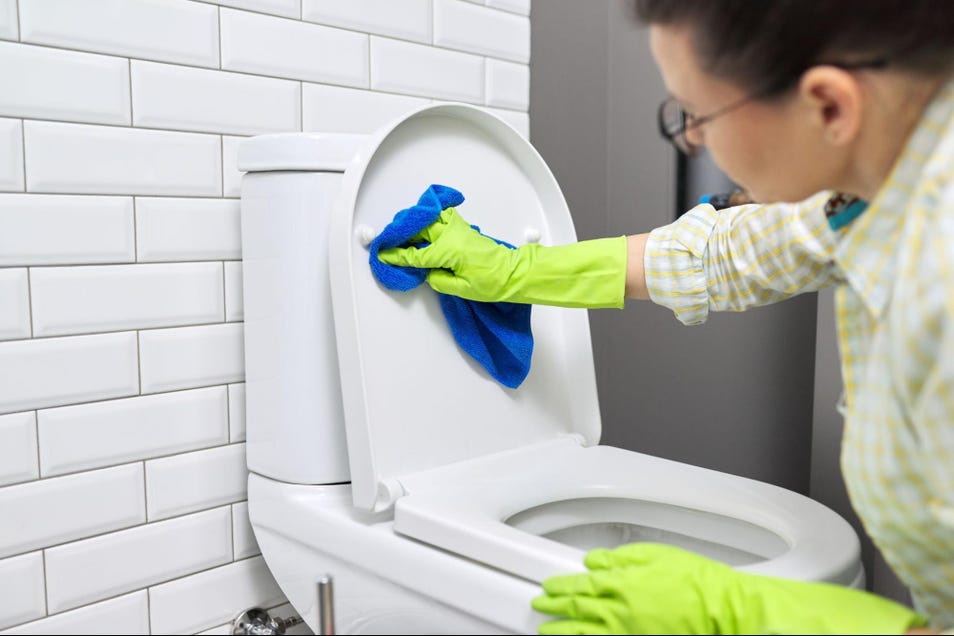The 5 Steps Toilet Maintenance Checklist

Toilets are the unsung heroes of our world, serving us constantly not for glory but just to keep our houses nice and clean. All that frequent use and less frequent cleaning can wear on your toilet and cause problems.
Fear not! We have created an easy-to-follow and understand toilet maintenance checklist, including the necessary supplies, instructions, and professional advice to transform your toilet and bathroom into a wellness oasis.
So, run through the maintenance checklist to make this task less daunting and more manageable, and ensure the toilet is sparkling clean, flawlessly maintained, and pristine.
Toilet Maintenance Checklist
1. Wear protective gear
Wear protective gear such as light-duty nitrile, vinyl, or latex gloves and goggles to avoid cross-contamination and protect your hands and eyes from germs, bacteria, and chemicals in the cleaning products.
2. Gather the required cleaning tools and prepare the area
Keeping the right cleaning tools readily available improves the pace and efficiency of toilet cleaning tasks.
The essential cleaning tools within your reach include a toilet brush, microfiber cloth, and a powerful toilet cleaner, such as Harpic PowerPlus Original, which removes limescale, rust, and 99.9% of bacteria and viruses.
Moreover, before you begin cleaning, remove all unnecessary and movable objects surrounding the toilet to reduce the risk of accidentally spilling cleaning solutions onto them. This step will also prevent cross-contamination and offer ample space to maneuver and clean effectively.
3. Cleaning the toilet bowl
Flush the toilet to moisten the bowl, and follow the steps below to remove dirt, dust, limescale, and rust from the insides of the toilet bowl.
Pour Harpic PowerPlus Orignal directly into the toilet bowl.
Direct the nozzle under the toilet bowl, rin, and squeeze the bottle gently.
Leave the toilet bowl cleaner for at least 10 minutes, giving the cleaning solution enough time to penetrate and break down the accumulated impurities.
Gently scrub the toilet bowl walls with a nylon-bristled scrub brush or sponge. If the impurities persist, add more Harpic PowerPlus Orignal during the scrubbing process for better results.
Flush the toilet multiple times with the lid closed to effectively remove any loosened residue while minimizing exposure to the toilet plume.
To acquire additional toilet cleanliness and freshness, hook Harpic Toilet Blocks to the bowl's rim where the strongest water pressure is. It will remove dust, dirt, and limescale and help you maintain a shiny toilet by offering continuous cleaning and freshness with every flush.
4. Wiping the toilet seat and outside area
After cleaning the toilet bowl inside, it is time to clean the toilet seat and outside area. Wipe down the toilet seat and all the external surfaces of the toilet bowl, tank, and base using a combination of Harpic Bathroom Cleaner Trigger and a rag, paper towels, or a sponge.
Remember to pay close attention to areas you frequently touch, such as flush handles, and dispose of used rags, paper towels, or sponges in a designated trash bin.
5. Examining the toilet tank
To examine the inside of the tank, you have to empty it. To achieve this, locate the control valve responsible for the water flow and rotate it clockwise to halt it. Afterward, flush the toilet repeatedly until the tank fully drains.
Drop the Harpic Flushmatic toilet cleaning cistern block in the toilet tank for continuous cleanliness and disinfection in the toilet bowl. With every flush, it releases a dose of powerful detergent foam that cleans and freshens, helping you maintain a hygienic and deodorized toilet.
Toilet maintenance tips: common problems
Let’s look at some of the most common preventable toilet problems.
Slow to drain toilet bowl: If your toilet bowl is taking a long time to drain, chances are that the holes under the bowl rim are clogged.
Solution: Using a wire hanger or any other wire tool, hook and remove the clog. Use a mirror to see where you must stick the wire to avoid unwanted scratches to the bowl.
Leaking seals: Over time, the seals on the toilet fixtures deteriorate, leaving homes vulnerable to water damage. Because several places on the toilet require seals, there are multiple spots to look for leaks.
Solution: Closely monitor and track these spots to identify where the leak comes from, and you’ll be able to pinpoint the seal that has gone bad.
Trickling water in the tank: If you notice water trickling from your tank, you must address it immediately. The problem usually originates from the water supply, and common culprits include the float, refill tube, ballcocks, or inlet valve. When any of these components malfunction, water may continuously trickle into the tank, and if not fixed, it could lead to more significant plumbing problems in the future.
Solution: Enlist the help of a professional plumber to make appropriate repairs or replacements.
FAQs
What are some common signs that a toilet needs maintenance?
Some of the most common signs that suggest it needs maintenance are:
Toilet leaks
Insufficient flushing
Running toilet
Repeated clogging
Mineral build-up and bad odor
Is it important to clean your toilet regularly as part of maintenance?
Yes, regular toilet cleaning is important for toilet maintenance and bathroom safety. It helps prevent the build-up of grime, stains, and bacteria and helps nurture a hygienic environment.
What steps can you take to ensure the longevity of my toilet's components?
Regularly checking for leaks and promptly addressing them, avoiding using harsh chemicals and cleaning products, ensuring proper flushing and water flow, and scheduling professional inspections by a certified plumber are some steps to ensure the longevity of your toilet’s components.
.png?width=70&height=88&format=png&quality=50)